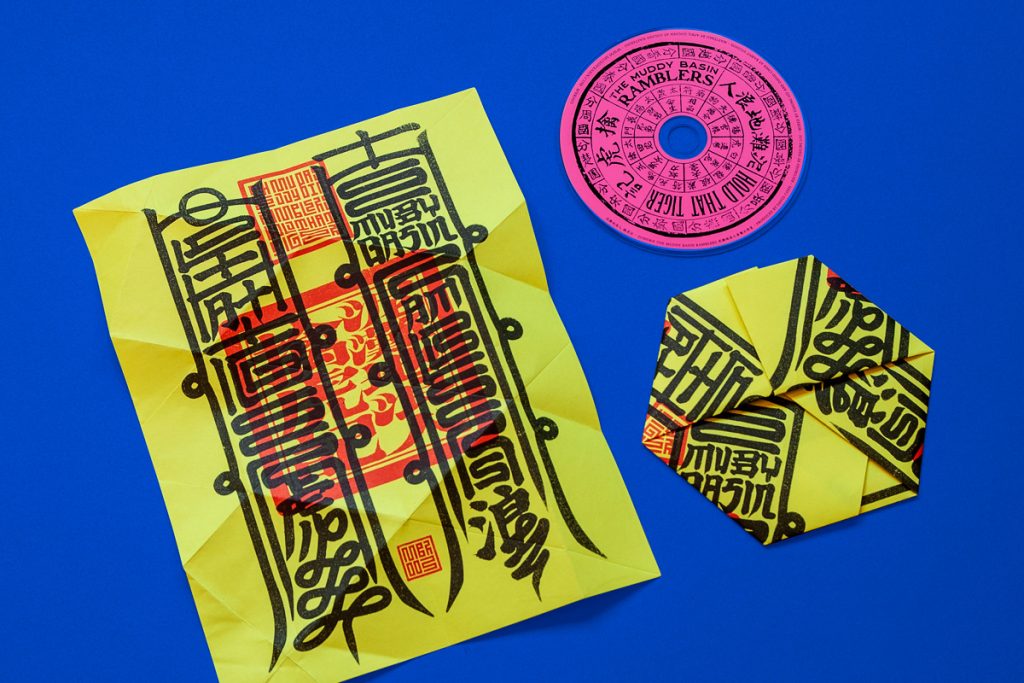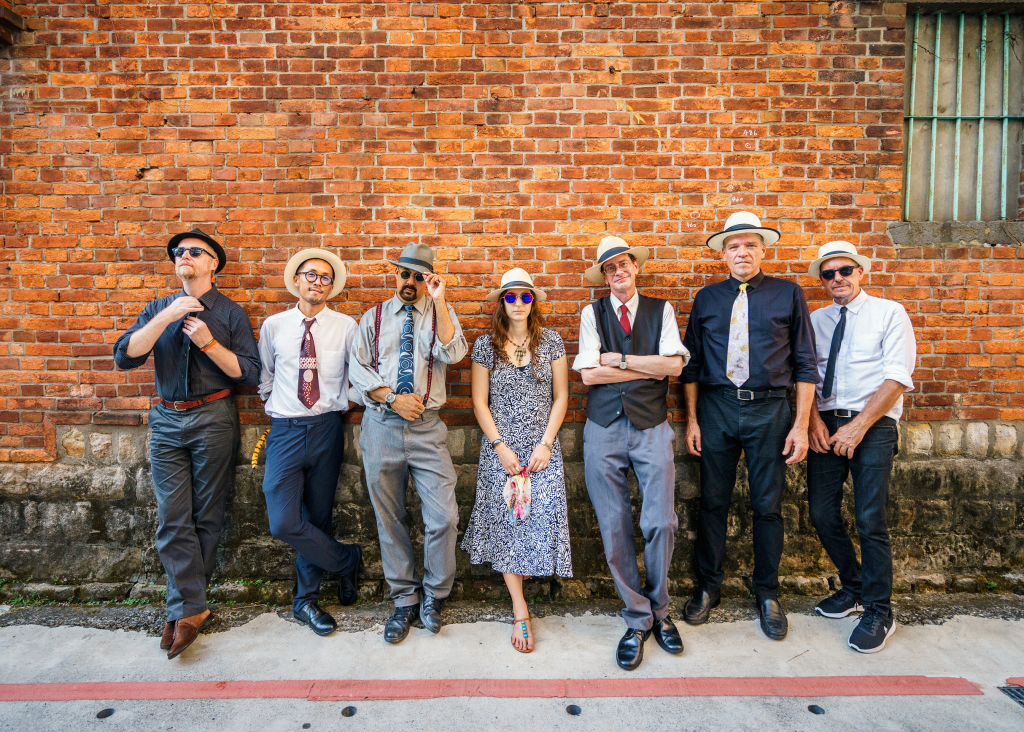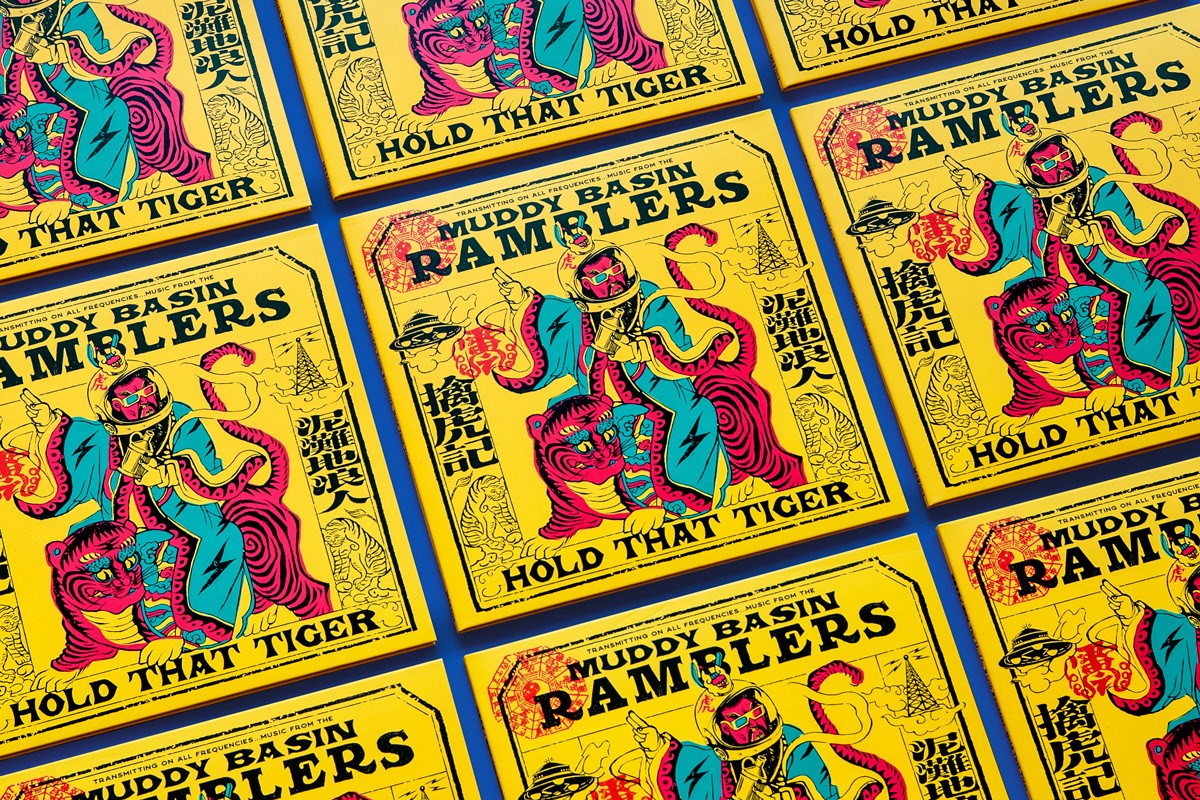2020 marks nearly two decades of rambling, rollicking, multi-cultural jug band madness for Taipei's Muddy Basin Ramblers, and the year couldn't be getting off to a better start for David Chen and his rag-tag gang of expatriate blues/roots/swing music virtuosos.
This Sunday, January 26th, the band will tune in to the 62nd annual Grammy Awards, where their latest album, an 18-song multi-genre opus by the name of Hold That Tiger, is nominated for Best Recording Package, the band's second nomination in the category at the vaunted L.A. gathering of the recording industry's best and brightest.
As the Grammys draw near, Taiwan Beats caught up with Chen, leader and chief songwriter of this staple of the Taipei music scene, to talk about the Grammy nom and all things MBR.
Let's talk first about the Grammy-nominated design work done for Hold That Tiger. Did you give designers Andrew Wong and Yang Fong-ming a lot of input or direction when it came to the visual themes, or was it more a case of just giving them the broad strokes and letting them run with it?
It was more the latter. I was more hands-on when we first worked together on Formosa Medicine Show (the band's 2013 album that was nominated for a Grammy for Best Packaging in 2015). This time around, I offered some basic visual ideas to start with, but I only spent an hour or so with them explaining the album concept, gave them a copy of the songs and lyrics, and left them to it. What's always amazed me about Andrew, Fong-ming, and everyone else at Onion Design is their skill at translating the abstract (music) into the visual. Much of that magic comes from dogged diligence, research, and experimentation. For example, the cover with the Chinese-styled Tiger and Warrior-Guard is the result of those guys poring through stacks of history books on the Chinese zodiac and folk religion symbols from antiquity, then endlessly tweaking their design to fit the vibe of the album. They spent a fair amount of time listening to the music, too. Fong-ming seems to know the songs as well as anyone in the band, and he and Andrew often went back to the lyrics for ideas. Also, they'll spend days, sometimes weeks, just studying different typefaces (fonts) from a certain era, so they can create their own, often by hand! I love observing them at work. Their process seems to mirror the music production side, kind of like the process of mixing and mastering tracks. It can be slow, painstaking labor, but it's so fulfilling to watch the results come to life.
There's a lot to take in with the design for the cover, the liner notes, and the sleeve, with elements taken from Taiwan's folk culture, Taoist mysticism, Western retro-futurism, and even Chinese esoteric texts. How do you feel all these components reflect in whole or in part the varied influences that come together to make the Muddy Basin Ramblers' sound?
In general, we like variety in our repertoire, mainly to keep ourselves entertained, not to mention the listener. With Hold That Tiger, there is a lot happening visually because there is a lot happening in the music. We think of the album as a self-contained world. There are 18 songs, all with different yet interconnected stories. Lyrically, the songs cover a large range of subjects and themes: jazz history, the Beat generation, Taiwanese seafarers, an Asian American labor activist, and folk religion, and a UFO cult to boot. Musically, there's also a wide stylistic variety, at least within the folk/roots music realm. You have pre-war blues, swing jazz, sea shanties, a Balkan melody, Taiwanese folk, and Nakashi. But everything links together in a broader theme. I think of the album as a "spiritual quest" in the sense that the characters in each song are searching for religion of some kind, or else trying to give it up.
One of the things that truly makes the album's design one-of-a-kind is the fact that, using an origami hexagon folding technique, the sleeve can be made to resemble a traditional Taiwanese amulet. Where did that idea come from?
That came from Fong-ming and Andrew. Early on, I told them one specific visual idea I had in mind, which were the illustrations and calligraphy you see on "spirit/ghost money" and folk religion paraphernalia in Taiwan. To me, the amulet idea works so well, especially in light of the song "Temple Blues," which is inspired by soundscapes from Taiwanese temple ceremonies and is full of big drum sounds and the Suona (the Chinese reed horn). When I first saw the amulet design, it dawned on me that Fong-ming and Andrew realized something I hadn't about the album: the music is a good luck charm of sorts. Playing it is kind of like casting a protective spell. "Jug Band Voodoo," if you will, haha...

This is the second Grammy nod for Onion Design Associates and the Ramblers. Aside from the designers themselves, I'm wondering what the Grammy nomination means to the members of the band?
We still pinch ourselves about the first nomination back in 2015. It's certainly nice for bragging rights for a week or two, and it's nice to have positive news to share with our friends and family. But at the end of the day for the band members, life goes on as usual. We're pretty much like any working indie band anywhere in the world. Most of us have day jobs, we play gigs when we can, and we're always keen to play for new audiences.
The Muddy Basin Ramblers occupy a unique space in the Taiwanese music scene. As far as I know, there isn't really a swing/blues/jug band niche here, aside from your band, so it's really a space that you have unto yourselves. What's it like, being such an anomaly?
I like to joke: "We're Taiwan's No. 1 Jug Band! And we're also Taiwan's ONLY jug band." Seriously, we don't think about it too much. We just love to play live, especially for folks who enjoy it. So far, we've had pretty good luck in our fifteen plus years doing this. Over the years, we've been fortunate enough to get invited to play at a wide variety of places and occasions, everything from rock festivals to weddings, luxury brand store openings to temple ceremonies... our bucket list is full of checkmarks!
The style of the Ramblers seems to always have borrowed from both East and West. The base of the sound of course comes from swing/blues, among others, but lyrically and musically there have always been nods to Taiwanese and Chinese culture. How do you go about bringing these different cultural and musical elements into a coherent mix?
It's pretty natural for us. We try not to force things. The way I see it, we like playing "old-time" music, but we also like to put our own spin on it, which happens to have a Taiwanese influence. All of us in the band are long-term expats (from the US and UK). Most of us have lived in Taiwan for more than 20 years. We're well familiar with the culture of Taiwan and to a lesser extent, the Chinese-speaking world. It's a part of who we are. We have our unique view of Taiwan as expats, but our day-to-day lives consist of "ordinary Taipei life," we're exposed to the same people, sounds, smells, sights, traffic, troubles and joys as the average Taiwanese person. All this gets woven into our music without too much thought.
Since the band's self-titled debut (David Chen and the Muddy Basin Ramblers), how do you feel the band has evolved musically and stylistically?
We started out playing trying to play faithful versions of blues/jazz/string band standards and traditionals, and then discovered it was even more meaningful and fun for us to play our own material based on those styles. So, with the first album, we wanted to show we could do a decent job playing classic songs. A couple of us in the band are roots music nerds. We like to study old, obscure records from the 1920s and 30s. But the others aren't so much; they prefer playing original stuff. To keep everyone interested and happy, I started writing songs specifically for the band in the style of pre-war (World War II) music. That's when I realized I had jumped into a rabbit hole. I started seeing parallels between the early 20th century pop traditions between Taiwan and the US. That inspired many songs on Formosa Medicine Show, an album remains important to us today as those songs have taken on such a deeply personal meaning to us. It's kind of our "Taiwan story" as a band.

Online, your latest album, Hold That Tiger, was tagged as your most adventurous record to date. How do you feel this recording earns that title?
The folk roots music scene tends to emphasize maintaining "authenticity" and tradition, which is well and fine. But for Hold That Tiger, I wanted to push the limits of tradition and make an album more modern and relevant to us (our world) today. We wanted to be a bit more "daring" in our stylistic realm. A fair number of songs on "Tiger" may sound traditional or "old school," but lyrically, they're a little more modern rock in their sensibility, more stream-of-consciousness and verbally dense a la hip hop. Topically, I wanted the songs to resonate with the craziness of the world today. Sonically, we made a conscious effort to mash and blend different styles. For example, on one tune, we mixed Gypsy Jazz with Nakashi (Taiwanese version of Enka, a Japanese folk song form), and then on another, we made a sea shanty based on an Okinawan melody.
Old jazz and blues songs tend to be tales of vanilla romance or mild debauchery. For Hold That Tiger, I tried to modulate within that "universe" by digging deeper and telling different kinds of stories. Lyrically I try to add my own twist to standard folk tales and mythology wherever possible, and I'm fascinated by the lives and stories of artists themselves. I had been reading a lot of oral history by jazz musicians, and separately, at the same time, the Beat generation's interest in jazz and blues (the hipster music of the 50s). This also gave me the idea to write lyrics about pop culture mythology from new angles. "Zen Beat Rag" is told from the point of view of an inconsequential character in an Allen Ginsburg poem described only as "the Chinaman of Oklahoma." "Mosquito Bop" is partly about how Cab Calloway derided Dizzy Gillespie for playing "Chinese" music. Basically, it's about the battle between generations, the swing cats vs. the bop cats. There's also a song about Carlos Bulosan, a little-known but talented Filipino-American novelist who was a labor activist and champion of the socialist movement in the US in the 1940s. "Beer Drinking Woman and a UFO" is based on a true story: in the 1990s, a Taiwanese sociology professor started a doomsday cult and led his followers to a suburban town in Texas, where they waited for Jesus to arrive on a spaceship.
These tunes are delivered in old-time formats—be it 1940s swing jazz, 1920s string band or a gypsy Balkan tune—but we're keen on "remixing" the styles, so as to leave our own imprint as a band. And we do embrace the "digital black magic" of modern-day technology. We've got some electronic loops and sampled soundscapes sprinkled throughout the album.
Also, our material is based on "American" folk music, which borrows everywhere and from everyone, so why not play up the Asian elements, too? I got inspired after learning that the Suona is still used in Cuba today in outdoor parade music. In New Orleans, the Chinese tom drum, which likely was brought there by Cantonese-Hakka immigrants, used to be a part of the standard jazz drum kit during the swing era. Learning those bits of history made me want to push these elements in our sound.
Plus, with all these old songs that I love, lyrically, none of them exactly fit my own story, as an American son of Taiwanese immigrants in Appalachian Ohio. So I tried to have some fun by rolling my own, and adding my own perspective and experiences.
2018 marked 15 years of rambling for you and the band? I know it's probably near-impossible to pin down, but if you could choose just one highlight from the past decade and a half of touring and performing, what would it be?
Sorry, this one's too hard. Here's three: The first was our "breakout show" in 2003 at the Daan Forest Park in 2003 for the Migration Music Festival. We were nervous; I had little experience as a live performer. But it was such a thrill to play for the 1,000 or so that were there. We got the rock n' roll bug then. The second, we played at the Yokohama Jug Band Festival in Japan in 2015. Imagine a big room full of 60 jug bands, all clanging away at washboards and homemade tub basses. It was ridiculous and touching the same time. We'd found our tribe. Third: our biggest audience ever was for 8,000 people outdoors at the National Concert Hall's Summer Jazz Party in 2017. It wasn't an especially amazing performance for us, but the vibe was good and there was even a little drama. Our percussionist Tim broke his arm the night before, but showed up anyway, running on painkillers, arm in a sling. He played the washboard with the other arm. He received some extra cheers from the audience.
And finally, what's up next in the life of David Chen and the Muddy Basin Ramblers as far as touring, recording, and everything else?
It always takes us a while to recover from making an album, since the process usually takes up to two years. We're on a five-year cycle. It's been roughly five years between our first, second and third full-length albums. We don't really subscribe to the industry model of putting an album out every year or so. It's not possible for us, as we have day jobs, families, and busy lives as middle-aged folk. We like to take our time. For now, we'll still be playing gigs here and there to promote Hold That Tiger. We are working on some new material, as we've been learning and re-arranging some older Taiwanese folk songs, so you're likely to hear us singing a few more in Taiwanese and Mandarin.





